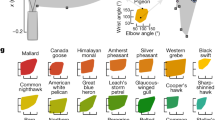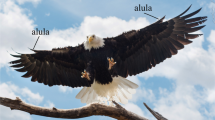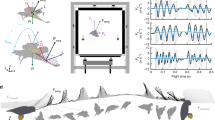Abstract
Despite profound musculoskeletal differences, hummingbirds (Trochilidae) are widely thought to employ aerodynamic mechanisms similar to those used by insects. The kinematic symmetry of the hummingbird upstroke and downstroke1,2,3 has led to the assumption that these halves of the wingbeat cycle contribute equally to weight support during hovering, as exhibited by insects of similar size4. This assumption has been applied, either explicitly or implicitly, in widely used aerodynamic models1,5,6,7 and in a variety of empirical tests8,9. Here we provide measurements of the wake of hovering rufous hummingbirds (Selasphorus rufus) obtained with digital particle image velocimetry that show force asymmetry: hummingbirds produce 75% of their weight support during the downstroke and only 25% during the upstroke. Some of this asymmetry is probably due to inversion of their cambered wings during upstroke. The wake of hummingbird wings also reveals evidence of leading-edge vortices created during the downstroke, indicating that they may operate at Reynolds numbers sufficiently low to exploit a key mechanism typical of insect hovering10,11. Hummingbird hovering approaches that of insects, yet remains distinct because of effects resulting from an inherently dissimilar—avian—body plan.
This is a preview of subscription content, access via your institution
Access options
Subscribe to this journal
Receive 51 print issues and online access
$199.00 per year
only $3.90 per issue
Buy this article
- Purchase on Springer Link
- Instant access to full article PDF
Prices may be subject to local taxes which are calculated during checkout



Similar content being viewed by others
References
Weis-Fogh, T. Energetics of hovering flight in hummingbirds and in Drosophila. J. Exp. Biol. 56, 79–104 (1972)
Stolpe, V. M. & Zimmer, K. Der Schwirrflug des Kolibri im Zeitlupenfilm. J. Ornithol. 87, 136–155 (1939)
Greenwalt, C. H. The wings of insects and birds as mechanical oscillators. Proc. Am. Phil. Soc. 104, 605–611 (1960)
Wilmott, A. P. & Ellington, C. P. The mechanics of flight in the hawkmoth Manduca sexta. II. Aerodynamic consequences of kinematic and morphological variation. J. Exp. Biol. 200, 2723–2745 (1997)
Rayner, J. M. V. A vortex theory of animal flight. I. The vortex wake of a hovering animal. J. Fluid Mech. 91, 697–730 (1979)
Ellington, C. P. The aerodynamics of hovering insect flight. V. A vortex theory. Phil. Trans. R. Soc. Lond. B 305, 79–113 (1984)
Norberg, U. M. Vertebrate Flight: Mechanics, Physiology, Morphology, Ecology, and Evolution (Springer, Berlin, 1990)
Wells, D. Muscle performance in hovering hummingbirds. J. Exp. Biol. 78, 39–57 (1993)
Tobalske, B. W., Altshuler, D. L. & Powers, D. R. Take-off mechanics in hummingbirds (Trochilidae). J. Exp. Biol. 207, 1345–1352 (2004)
van den Berg, C. & Ellington, C. P. The vortex wake of a ‘hovering’ model hawkmoth. Phil. Trans. R. Soc. Lond. B 352, 329–340 (1997)
Dickinson, M. H., Lehmann, F. & Sane, S. P. Wing rotation and the aerodynamic basis of insect flight. Science 284, 1954–1960 (1999)
Dudley, R. The Biomechanics of Insect Flight (Princeton Univ. Press, Princeton, 2000)
Altshuler, D., Dudley, R. & Ellington, C. P. Aerodynamic forces of revolving hummingbird wings and wing models. J. Zool. (Lond.) 264, 327–332 (2004)
Willmott, A. P. & Ellington, C. P. The mechanics of flight in the hawkmoth Manduca sexta. I. Kinematics of hovering and forward flight. J. Exp. Biol. 200, 2705–2722 (1997)
Willmott, A. P., Ellington, C. P. & Thomas, A. L. R. Flow visualization and unsteady aerodynamics in the flight of the hawkmoth Manduca sexta. Phil. Trans. R. Soc. Lond. B 352, 303–316 (1997)
Usherwood, J. R. & Ellington, C. P. The aerodynamics of revolving wings. I. Model hawkmoth wings. J. Exp. Biol. 205, 1547–1564 (2002)
Tytell, E. D. & Ellington, C. P. How to perform measurements in a hovering animal's wake: physical modelling of the vortex wake of the hawkmoth, Manduca sexta. Phil. Trans. R. Soc. Lond. B 358, 1559–1566 (2003)
Tobalske, B. W., Hedrick, T. L. & Biewener, A. A. Wing kinematics of avian flight across speeds. J. Avian Biol. 34, 177–184 (2003)
Wootten, R. J. Geometry and mechanics of insect hindwing fans: a modelling approach. Proc. R. Soc. Lond. B 262, 181–187 (1995)
Combes, S. A. & Daniel, T. L. Into thin air: contributions of aerodynamic and inertial-elastic forces to wing bending in the hawkmoth Manduca sexta. J. Exp. Biol. 206, 2999–3006 (2003)
Spedding, G. R., Hendenstrom, A. & Rosen, M. Quantitative studies of the wakes of freely flying birds in a low-turbulence wind tunnel. Exp. Fluids 34, 291–303 (2003)
Raffel, M., Willert, C. & Kompenhans, J. Particle Image Velocimetry: A Practical Guide (Springer, Berlin, 2000)
Spedding, G. R., Rosen, M. & Hedenstrom, A. A family of vortex wakes generated by a thrush in free flight in a wind tunnel of its entire natural range of flight speeds. J. Exp. Biol. 206, 2313–2344 (2003)
Hedrick, T. L., Tobalske, B. W. & Biewener, A. A. Estimates of gait change based on a three-dimensional analysis of flight in cockatiels (Nymphicus hollandicus) and ringed turtle doves (Stretopelia risoria). J. Exp. Biol. 205, 1389–1409 (2002)
Acknowledgements
We thank B. Klopfenstein for her help with the experiments. This work was supported by grants from the National Science Foundation and the Murdock Charitable Trust.
Author information
Authors and Affiliations
Corresponding author
Ethics declarations
Competing interests
Reprints and permissions information is available at npg.nature.com/reprintsandpermissions. The authors declare no competing financial interests.
Rights and permissions
About this article
Cite this article
Warrick, D., Tobalske, B. & Powers, D. Aerodynamics of the hovering hummingbird. Nature 435, 1094–1097 (2005). https://doi.org/10.1038/nature03647
Received:
Accepted:
Issue Date:
DOI: https://doi.org/10.1038/nature03647
This article is cited by
-
Investigate the Wake Flow on Houseflies with Particle-Tracking-Velocimetry and Schlieren Photography
Journal of Bionic Engineering (2023)
-
Limit cycle oscillation suppression controller design and stability analysis of the periodically time-varying flapping flight dynamics in hover
Nonlinear Dynamics (2022)
-
The Unique Strategies of Flight Initiation Adopted by Butterflies on Vertical Surfaces
Journal of Bionic Engineering (2021)
-
Development of a Bird-like Flapping-wing Aerial Vehicle with Autonomous Take-off and Landing Capabilities
Journal of Bionic Engineering (2021)
-
Interplay of the leading-edge vortex and the tip vortex of a low-aspect-ratio thin wing
Experiments in Fluids (2020)
Comments
By submitting a comment you agree to abide by our Terms and Community Guidelines. If you find something abusive or that does not comply with our terms or guidelines please flag it as inappropriate.



